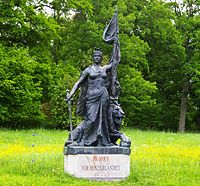- Mother Svea
-
Mother Svea (Swedish: Moder Svea) is the female personification of Sweden and a patriotic emblem of the Swedish nation.
Contents
Background
Mother Svea is normally depicted as a powerful female warrior, valkyrie or shieldmaiden, frequently holding a shield and standing beside a lion. Svea is a Swedish female personal name which derives from svea, an old plural genitive form meaning "of the Swedes" or the Swea. It appears in Svea rike meaning "kingdom of the Swedes" (Swea Region), an older form of Sverige, the Swedish name for Sweden.
The popular image is considered to have been created by Swedish writer, Anders Leijonstedt (1649–1725) when first introduced in his poem Svea Lycksaligheets Triumph (1672).[1]
As a patriotic symbol, Moder Svea gained widespread popularity in Kunga Skald (1697), written by Swedish poet Gunno Eurelius (1661–1709) in honor of King Charles XI of Sweden. Eurelius was later ennobled with the name of Dahlstjerna.[2]
Mother Svea appeared frequently as a national symbol in 19th century Swedish literature and culture. She appeared on various Swedish banknotes for over seventy years, such as both the 5-kronor banknote printed between 1890–1952 and the 5-kronor banknote printed between 1954-1963.[3]
Swedish singer Lena Philipsson and composer Torgny Söderberg wrote a song entitled Moder Swea which was introduced in the 1995 album Lena Philipsson.[4]
See also
- National personification
- Flag of Sweden
- National anthem of Sweden
- Three Crowns
References
Sources
- Algulin, Ingemar, and Bernt Olsson Litteraturens historia i Sverige (Stockholm, 1987)
External links
 National symbols of Sweden
National symbols of SwedenNational flag · Coat of arms · National anthem · Three Crowns · Mother Svea
National personifications - Argentina
- Effigies of Argentina
- Armenia
- Mother Armenia
- Brazil
- Efígie da República
- Cambodia
- Preah Thong and Neang Neak
- Canada
- Johnny Canuck
- Finland
- Finnish Maiden (Suomi-neito)
- France
- Marianne
- Georgia
- Kartlis Deda
- Germany
- Deutscher Michel
- Germania
- Greece
- Athena
- "Greece" of Delacroix
- Iceland
- Lady of the Mountain
- India
- Bharat Mata
- Indonesia
- Ibu Pertiwi
- Ireland
- Ériu
- Hibernia
- Kathleen Ni Houlihan
- Israel
- Srulik
- Italy
- Italia Turrita
- Japan
- Amaterasu
- Malaysia
- Ibu Pertiwi
- Netherlands
- Netherlands Maiden
- New Zealand
- Zealandia
- Norway
- Ola Nordmann
- Pakistan
- Pak Watan
- Philippines
- Juan dela Cruz
- Maria Clara
- Poland
- Polonia
- Portugal
- Efígie da República
- Zé Povinho
- Russia
- Mother Russia
- Spain
- Hispania
- Sweden
- Mother Svea
- Switzerland
- Helvetia
- Ukraine
- Cossack Mamay
- United Kingdom
- Britannia
- John Bull
- Dame Wales

This sculpture article is a stub. You can help Wikipedia by expanding it.


